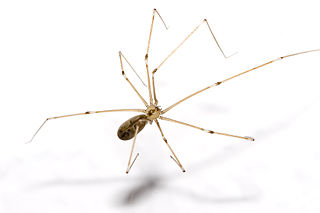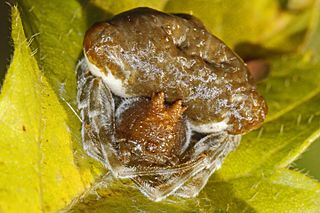
The Araneomorphae are an infraorder of spiders. They are distinguishable by chelicerae (fangs) that point diagonally forward and cross in a pinching action, in contrast to the Mygalomorphae, where they point straight down. Araneomorphs comprise the vast majority of living spiders.

Desidae is a family of spiders, some of which are known as intertidal spiders. The family is named for the genus Desis, members of which live in a very unusual location — between the tides. The family has been reevaluated in recent years and now includes inland genera and species as well, such as Badumna and Phryganoporus. In 2017, the family Amphinectidae was merged into Desidae. The family Toxopidae has been separated off. Those intertidal spiders that are truly marine commonly live in barnacle shells, which they seal up with silk; this allows them to maintain an air bubble during high tide. They emerge at night to feed on various small arthropods that live in the intertidal zone.

The Pholcidae are a family of araneomorph spiders. The family contains over 1,800 individual species of pholcids, including those commonly known as cellar spider, daddy long-legs spider, carpenter spider, daddy long-legger, vibrating spider, gyrating spider, long daddy, and skull spider. The family, first described by Carl Ludwig Koch in 1850, is divided into 94 genera.

Titanoecidae is a family of araneomorph spiders first described by Pekka T. Lehtinen in 1967. It is fairly widespread in the New World and Eurasia with five genera and more than 50 species worldwide. These are mostly dark-colored builders of "woolly" (cribellate) silk webs. Several species are found at relatively high altitudes in mountain ranges and may be very common in such habitats.

Titanoeca is a genus of spiders that occurs mainly in Eurasia, with three species found only in North America. One species has a holarctic distribution, and T. guayaquilensis is endemic to Ecuador.

Titanoeca quadriguttata is a species of spider in the family Titanoecidae. It is widespread in Europe, though absent from Great Britain, and is found in Austria, Belgium, Bulgaria, Corsica, Croatia, Czech Republic, France, Germany, Greece, Hungary, Italy, Liechtenstein, Moldova, Russia, Slovakia, Spain, Switzerland, the Netherlands, Ukraine.
Titanoeca tristis is a species of araneomorph spider in the family Titanoecidae. It is found from Europe to Central Asia.

Titanoeca nivalis is a species of araneomorph spider in the family Titanoecidae. It has a Holarctic distribution.

Pseudoplectania nigrella, commonly known as the ebony cup, the black false plectania, or the hairy black cup, is a species of fungi in the family Sarcosomataceae. The fruit bodies of this saprobic fungus are small blackish cups, typically up to 2 cm (0.8 in) broad, that grow in groups on soil, often amongst pine needles and short grass near coniferous trees. Pseudoplectania nigrella has a worldwide distribution, and has been found in North America, the Caribbean, Britain, Europe, India, Madagascar, New Zealand, and Japan. The fungus produces a unique chemical compound, plectasin, that has attracted research interest for its ability to inhibit the growth of the common human pathogenic bacterium Streptococcus pneumoniae.

Alireza Zamani is an Iranian arachnologist and taxonomist.
Renardia nigrella is a species of unmargined rove beetle in the family Staphylinidae.
Pygoleptura nigrella is a species of flower longhorn in the beetle family Cerambycidae. It is found in North America.

Chaetarthria is a genus of water scavenger beetles in the family Hydrophilidae. There are more than 20 described species in Chaetarthria.
Micracisella is a genus of typical bark beetles in the family Curculionidae. There are at least 20 described species in Micracisella.

Philodromus marxi, the metallic crab spider, is a species of running crab spider in the family Philodromidae. It is found in the United States. They are a sexually dimorphic species. The males are smooth with a metallic sheen and the females present as bristly white and grey.

Mastophora phrynosoma is a species of orb weaver in the spider family Araneidae. It is found in the United States. Like all known species of the genus Mastophora, adult females are bolas spiders, capturing their prey with one or more sticky drops at the end of a single line of silk rather than in a web. Males and juvenile females capture their prey directly with their legs.

Phidippus comatus is a species of jumping spider in the family Salticidae. It is found in North America.

Titanoeca americana is a species of true spider in the family Titanoecidae. It is found in North America.














